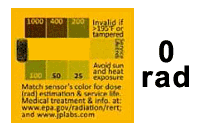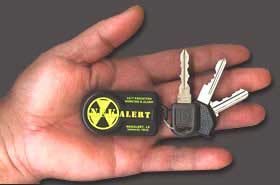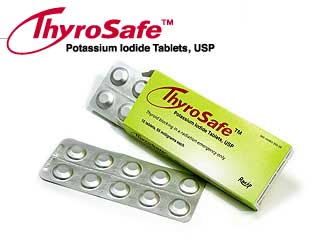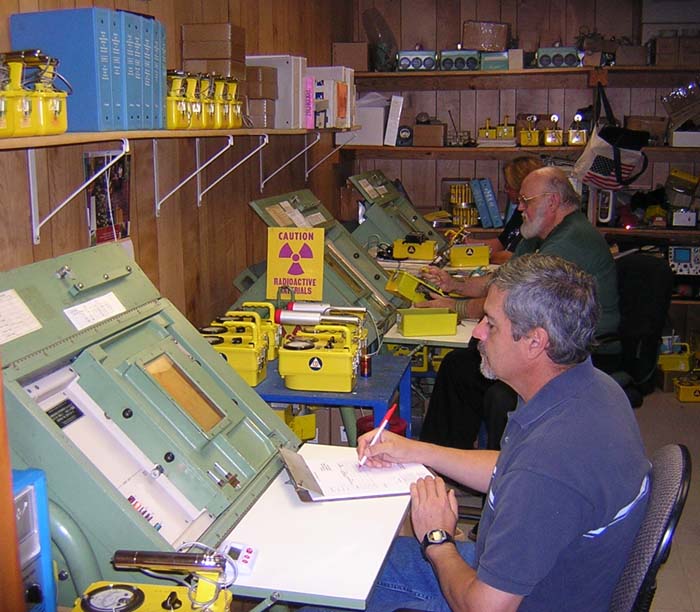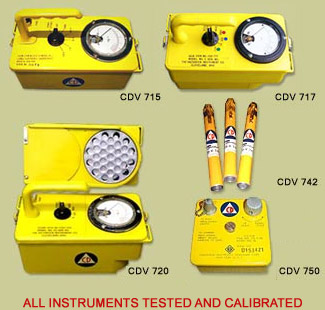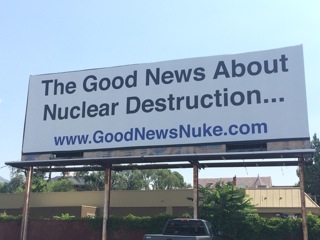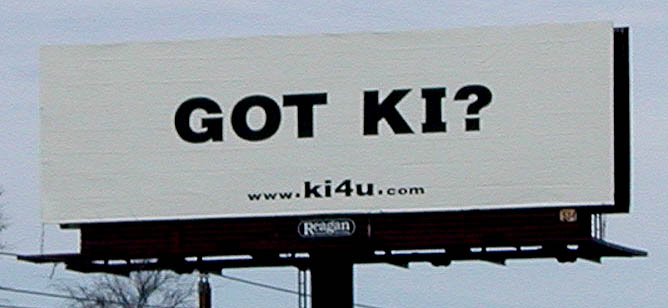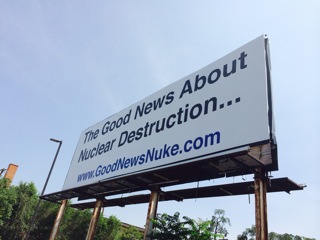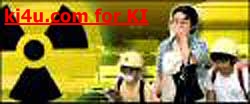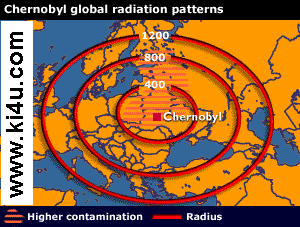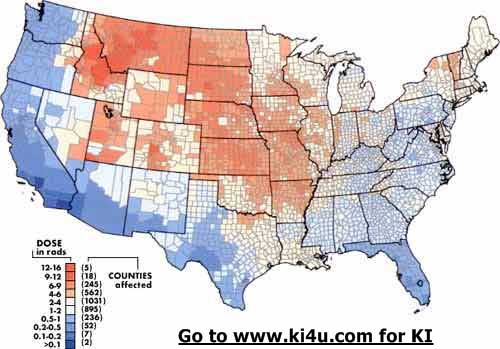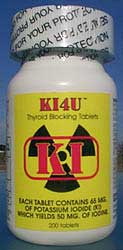'Surviving A Nuclear Disaster!' YT Interview (12/20/2013) ~ 'Campaign:1950s NUKE SURIVAL SKILLS NEEDED NOW' WND (7/20/2014) |
| Last Updated: September 1st, 2014 | ||||
KI4U Nuke Prep Expertise & Solutions!If you do nothing else here, read our myth-busting expose...The Good News About Nuclear Destruction! ...and then our popular & essential family guide for... What To Do If A Nuclear Disaster Is Imminent! ...and our latest guide detailing protection from overseas fallout... When An ill Wind Blows From Afar! (Like From Japan Fukushima Nuclear Crisis)
We've been promoting Nuclear Civil Defense Training of the public for well over a decade! FREE Radiation Contamination Testing For Your Home & Local Area!
BTW, We are no 'Johnny-Come-Lately' sounding the call to prepare!
Check out our pre 9/11 Press Releases in
1999 and
2000,
too! So, you might want to see what we've been doing recently in SLC, UT July, 2014... Be sure to also read our very popular guides...
The Good News About Nuclear Destruction! What To Do If A Nuclear Disaster Is Imminent!
When An ill Wind Blows From Afar! Overseas Fallout Coming Here!
And, here's a few of our other KI4U 'adventures' of interest...
Story & Photos of KI4U, Inc. New Orleans Katrina Emergency Response!
Venezuela's Chavez 'Clear and Present Danger' revealed here a decade ago!
| ||||
 |
 |
 |
| Potassium
Iodide Anti-Radiation Pill FAQ & iodine tablets, pills, sources |
 |
| Last Updated: September 1st, 2014 | |
|
SOURCES: Nuclear Regulatory Commission, New England Journal of Medicine,
Nuclear War Survival Skills, National Council on Radiation Protection and
Measurements, Federal Register, Memorial Sloan-Kettering Cancer Center,
Food and Drug Administration, Department of Health and Human Services,
Salt Institute, Morton® Salt, Solgar®, American Thyroid Association,
Physicians for Civil Defense, The United States Pharmacopeial Convention,
Inc., USP Drug Research and Testing Laboratory, Oak Ridge National
Laboratory, National Cancer Institute, Federal Emergency Management Agency,
Health Physics Journal, Mayo Foundation for Medical Education and Research,
World Health Organization, Center for Drug Evaluation and Research,
United States Disaster Preparedness Institute (Forward additional relevant
resources or suggestions for this FAQ
to:webmaster@ki4u.com) | |
|
A: Documentation and details of the following (and much more) are below in the FAQ:
Researchers at the World Health Organization accurately located and counted the cancer victims from Chernobyl and were startled to find that "the increase in incidence [of thyroid cancer] has been documented up to 500 km from the accident site...significant doses from radioactive iodine can occur hundreds of kilometers from the site, beyond emergency planning zones." Consequently, far more people than anticipated were affected by the radiation, which caused the United Nations to report in 2002 that "The number of people with thyroid cancer...has exceeded expectations. Over 11,000 cases have already been reported."
A: Potassium Iodide (chemical name 'KI') is much more familiar to most than they might
first expect.
Potassium Iodide (KI) is approximately 76.5% iodine.
For purposes of radiation protection the Nuclear
Regulatory Commission (NRC) states in
COMSECY-98-016 - FEDERAL REGISTER NOTICE ON POTASSIUM IODIDE:
Most recently (November, 2001) the FDA states in Potassium Iodide as a Thyroid Blocking Agent in Radiation Emergencies: A: Going back to June 23, 1966, the New England Journal of
Medicine. Vol. 274 on Page 1442 states:
Cresson H. Kearny, the author of Nuclear War
Survival Skills, Original Edition Published September, 1979, by Oak Ridge National Laboratory,
a Facility of the U.S. Department of Energy (Updated and Expanded 1987 Edition) states on
page 111: However, a salt of the elements potassium and iodine, taken orally even in very
small quantities 1/2 hour to 1 day before radioactive iodines are swallowed or inhaled, prevents
about 99% of the damage to the thyroid gland that otherwise would result. The thyroid gland readily
absorbs both non-radioactive and radioactive iodine, and normally it retains much of this element in
either or both forms. When ordinary, non-radioactive iodine is made available in the blood for
absorption by the thyroid gland before any radioactive iodine is made available, the gland will absorb
and retain so much that it becomes saturated with non-radioactive iodine. When saturated, the
thyroid can absorb only about l% as much additional iodine, including radioactive forms that later
may become available in the blood: then it is said to be blocked. (Excess iodine in the blood is
rapidly eliminated by the action of the kidneys.)"
The Nuclear Regulatory Commission (NRC) stated July 1, 1998 in
USE OF POTASSIUM
IODIDE IN EMERGENCY RESPONSE:
Federal Register. Vol. 43 Friday, December 15, 1978, states in Potassium
Iodide as a Thyroid Blocking Agent in a Radiation Emergency:
National Council on Radiation Protection and Measurements. NCRP Report
NO. 55. Protection of the Thyroid Gland in the Event of Releases of
Radioiodine. August, 1979, Page 32:
The recently updated (1999) World Health Organization (WHO)
Guidelines for Iodine Prophylaxis following Nuclear Accidents states:
And, finally, the recently (November, 2001) released FDA document Potassium Iodide as a Thyroid Blocking Agent in Radiation Emergencies states: A: Sorry, but there is no magic pill or medicine that will
protect you from all radiation sources. In fact, as already stated above here:
Also, the recently (November, 2001) released FDA document Potassium Iodide as a Thyroid Blocking Agent in Radiation Emergencies states:
Potassium Iodide (and Potassium Iodate, KIO3) will provide a very high level of thyroid protection, taken
in time, for the specific radio-isotopes of iodine, which is expected by many to
cause the majority of health concerns downwind from a nuclear emergency.
(And, is the reason most all developed countries have stockpiled it.)
However, there are numerous other, and very dangerous, radioactive noble
gases and/or radioactive fallouts that can be associated
with nuclear emergencies. You are still exposed to inhale, ingest, or be
radiated externally from any number of dangerous non-radioiodine sources.
If you are ever directed to evacuate in a nuclear emergency, do so immediately,
regardless of whether you have taken Potassium Iodide (KI) or KIO3, or not.
Note: KI or KIO3 would likely not be needed for the so-called "Dirty Bomb" or RDD
(Radiological Dispersal Device).
Radioactive Iodine is only produced by a fission or fusion weapon detonation or in a Nuclear Power Plant as a byproduct of that process.
An RDD simply spreads around existing radioactive material and it's not very likely to have been composed of the relatively short
half-life radioactive iodine. We'd more likely see used in an RDD a commercially abundant, and more easily obtained, isotope
like Cobalt-60, Cesium-137 or uranium fuel rods, etc.
|
|
A:
The "bad news" first:
#1 - Radioactive iodine (predominantly iodine-131) is a major
radioisotope constituent in nuclear power plants.
#2 - There are 103 currently active commercial nuclear reactors and 39
operating nonpower reactors in the United States. (434 worldwide as of 1998.)
Additionlly, there are numerous other nuclear processing and storage
facilities worldwide with the potential for accidents, too.
The, September 29, 1999, Tokaimura, Japan nuclear accident took place, not in
a nuclear reactor power plant, but in an uranium processing plant.
#3 - Radioactive iodine (predominantly iodine-131) is also a major constituent of detonated nuclear weapons. #4 - Radioactive iodine can not only travel hundreds of miles on the winds, but also still remain health threatening even as other radioisotopes are becoming dispersed and diluted along with it and their likelyhood of causing harm diminishes. It is often overlooked that while there will also be many other dangerous radioisotopes released along with radioiodine, if they are inhaled or ingested they are normally dispersed throughout a body and pose less of a risk than if they were to be concentrated into one small specific area of the body, like radioiodine is in the thyroid gland. As a plume or cloud of radioactive isotopes disperses with the wind its danger also diminshes, but always much less quickly so for radioiodine because whatever little there is that's inhaled will always be concentrated into that small space of the thyroid gland. NUREG-1633 points out an increase in thyroid cancer caused by radioiodine from Chernobyl...
The recently updated (1999) World Health Organization (WHO) Guidelines for Iodine Prophylaxis following Nuclear Accidents states in its abstract regarding thyroid cancer caused by the Chernobyl disaster: "This increase in incidence has been documented up to 500 km from the accident site." ...and therefore... "...that stockpiling (KI or KIO3) is warranted, when feasible, over much wider areas than normally encompassed by emergency planning zones, and that the opportunity for voluntary purchase be part of national plans." Many are coming to see now that relying on the current U.S. policy of public safety contingency plans focused on only protecting the populations inside a small "Emergency Planning Zone" (EPZ) of 5 to 10 miles around U.S. nuclear power plants is "overly optimistic", to put it very mildly. Undoubtably, US nuclear power plants are much better designed, operated, and safer than many others elsewhere in the world, and certainly many magnitudes safer than the Chernobyl operation ever was. But, that doesn't mean much anymore when we aren't just concerned with just accidents, but now sabotage or terrorist attacks, too. Without anyone debating here how likely anything is to ever go wrong, it must still be accepted by all that the logic of even having any EPZ's established is to effectively provide for the public safety in that rarest of events if/when anything did go wrong. If that's why we've even bothered with having any EPZ's at all, then shouldn't they be effective ones, if/when it's ever really needed to protect the public downwind? Reality is, the wind just won't know to stop blowing when it comes up against the currently tiny 5-10-50 mile EPZ 'barriers'. (Find your upwind nuclear power plants and daily updated plant status reports here.) Also, read the fascinating Three Mile Island: The Rest of the Story... (Why current EPZ's are much too small.) The wind, of course, doesn't respect state boundaries either as our own Nevada atomic bomb testing program in the 1950s and early 1960s made it possible that "...everyone living in the contiguous 48 states was exposed to low levels of 131Iodine (radioiodine) for several months following each nuclear bomb test." (Radiation Exposure and Thyroid Cancer - Memorial Sloan-Kettering Cancer Center) Even more importantly; "The report also estimates that children aged three to five years probably received doses of radiation three to seven times higher than average during the 90 nuclear tests that were carried out." Remember, it's always the children who are at the highest risk of injury from radioactive iodine and eventually developing thyroid cancer from that exposure. Each year, more than 12,000 Americans find out they have thyroid cancer, though from various causes. About 1000 here in the U.S. die from it yearly.
And, of course, the wind also doesn't respect international boundaries either, nor even continents and oceans, as fallout from a single above ground Chinese nuclear test explosion ("a few hundred kilotons") on December 28, 1966 resulted in the fallout cloud covering most of the United States. From Cresson H. Kearny's Nuclear War Survival Skills: "It produced fallout that by January 1, 1967 resulted in the fallout cloud covering most of the United States. This one Chinese explosion produced about 15 million curies of iodine- 131 - roughly the same amount as the total release of iodine- 131 into the atmosphere from the Chernobyl nuclear power plant disaster." "Fallout from the approximately 300 kiloton Chinese test explosion shown in Fig. 1 caused milk from cows that fed on pastures near Oak Ridge, Tennessee and elsewhere to be contaminated with radioiodine, although not with enough to be hazardous to health. However, this milk contamination (up to 900 picocuries of radioactive iodine per liter) and the measured dose rates from the gamma rays emitted from fallout particles deposited in different parts of the United States indicate that trans-Pacific fallout from even an overseas nuclear war in which "only" two or three hundred megatons would be exploded could result in tens of thousands of unprepared Americans suffering thyroid injury." (Declassified Fallout Map and full story text in Nuclear War Survival Skills at Trans-Pacific Fallout) Getting Back To The Future... Commenting on the world health effects a nuclear exchange between India and Pakistan would create, for example, Dr. Henry Kendall of the Union of Concerned Scientists said in October of 1999: "It would be very similar to Cherynobl. But it could be on a substantially larger scale." Accordingly, you also have to assess the probable threat from nuclear war, either directed at the U.S. or fallout contamination originating from elsewhere in the world. Russia, China, North Korea, Pakistan, India, Iran, Israel, etc., where any of them are exchanging nuclear blasts with any of their neighbors, could have the prevailing west-to-east trade winds carrying the resultant radioactive fallout to our shores, too. You'll have to decide whether that's an impossible scenario
in your families lifetime, or not. #5 - Radioactive iodine (radioiodine) persists in the environment for a month or more. #6 - Most importantly, ingested or inhaled radioactive iodine (radioiodine) persists in the body and concentrates in the thyroid. (Excess iodine in the blood, either radioiodine or stable iodine, is quickly eliminated from the body, but only after the thyroid has become saturated with one or the other type of iodine.) Even very small amounts of radioactive iodine, because it is retained in the small space of the thyroid, eventually will give such a large radiation dose to thyroid cells there that abnormalities are likely to result. These would include loss of thyroid function, nodules in the thyroid, or thyroid cancer. The most likely to see the worst effects, in later life, are the youngest children. (Many of the Chernobyl thyroid cancers appearing in the former Soviet Union among young people today were just children less than five years old at the time of the accident. Experts now contend that as high as 40% of the nodules are cancerous with 5 to 10 percent of the cancers fatal.) Every year researchers are discovering more from Chernobyl as its legacy continues to reveal itself. According to the World Health Organization, that disaster will cause 50,000 new cases of thyroid cancer among young people living in the areas most affected by the nuclear disaster. Researchers have also found that in certain parts of Belarus, for example, 36.4 per cent of children, who were under the age of four at the time of the accident, can expect to develop thyroid cancer. For all of the above reasons, health experts estimate that the greatest health concerns affecting the largest number of people from a nuclear accident, or nuclear bomb explosion(s) anywhere in the world, will likely be from the release of radioactive iodine then carried downwind. However, there really is some Good News amongst all this!
This deadly cancer agent, especially to our children,
The Nuclear Regulatory Commission (NRC) states in COMSECY-98-016 - FEDERAL REGISTER NOTICE ON POTASSIUM IODIDE:
Also, the newly released (November, 2001) FDA document entitled: Potassium Iodide as a Thyroid Blocking Agent in Radiation Emergencies states:
What they learned was that children, with their thyroid glands being the most sensitive to radioactive iodine uptake, have today grown up to be the most frequent victims of thyroid cancers there. The children in Russia, the Ukraine and Belarus, where potassium iodide (KI) was not widely distributed, are now experiencing high levels of thyroid cancer. However, in Poland, where over 18 million doses of Potassium Iodide (KI) were administered, and to 97 percent of the children, there has been no similar increase in thyroid cancer. Also, key to Poland's radioiodine protective strategy, was their aggressive interdiction of radioiodine contaminated food stuffs and milk. Bottom Line: For all its serious potential for widespread damage to populations (and especially among our youngest), far downwind from the site of a nuclear event, radioiodine health concerns can be largely neutralized by inexpensive thyroid blocking via prompt prophylactic use of potassium iodide (KI). This, in addition to successful evacuation, when indicated, and vigilance that food and milk are not also radioiodine contaminated, has proven itself the best combination strategy. |
Q: Dosage and Safety Regarding Potassium Iodide (KI) Usage?A: In April of 1982 the Bureau of Radiological Health and Bureau of Drugs, Food and Drug Administration, Department of Health and Human Services released "FINAL RECOMMENDATIONS, Potassium Iodide As A Thyroid-Blocking Agent In A Radiation Emergency: Recommendations On Use". These lengthy recommendations are summarized in the FDA's "mandated patient product insert". (See a complete copy below.) This insert is packed with every bottle of non-prescription Potassium Iodide (KI) tablets sold. However, the lengthy FDA recommendations contain many facts not mentioned in this required insert, including the following:
(It should be pointed out that this extremely low adverse reaction rate is for doses over twice as large as the 130-mg prophylactic dose.) NOTE: The following 'old' FDA Recommendations were recently revised, but we share them here for any that wish to compare them with the current recommendations. See details and link to the newer (November, 2001) FDA guidelines immediately below this grey box.
The FDA new (November, 2001) guidance document, that brings it more in-line with the recent World Health Organization recommendations below, is titled; "Potassium Iodide as a Thyroid Blocking Agent in Radiation Emergencies". It can be seen here fda.htm. That document represents the Food and Drug Administration's current thinking on this topic. In regards to the differences between the World Health Organization dosing recommendations and these new FDA recommendations, this FDA document states:
*Adolescents approaching adult size (> 70 kg) should receive the full adult dose (130 mg). The World Health Organization recent recommendations has a step increase in doses by age (chart below) and also states the potential benefit diminishes with older adults. In fact, if only a limited number of Potassium Iodide (KI) or KIO3 tablets are available, these should always be given to infants, children and young adults first as they are the most vulnerable and also the risk of thyroid cancer fully developing begins to drop off with adults much over 40 years of age. The World Health Organization (WHO) Guidelines for Iodine Prophylaxis following Nuclear Accidents states:
Also, the newly released (November, 2001) FDA document entitled Potassium Iodide as a Thyroid Blocking Agent in Radiation Emergencies determined from the Chernobyl data that:
Dosing chart from the recently updated 1999 World Health Organization:
At the WHO dosages recommended above, an adverse reaction rate of less than 1 in 10 million children and less than 1 in 1 million adults is expected. However, Potassium Iodide should not be used by people allergic to iodine. According to the WHO, contraindications for use of potassium iodide are: (1) past or present thyroid disease (e.g., active hyperthyroidism), (2) known iodine hypersensitivity, (3) dermatitis herpetiformis, and (4) hypocomplementaemic vasculitis. You should also check with your doctor before taking this medication if you have myotonia or hyperkalemia congenita or tuberculosis or kidney disease. See http://www.mayoclinic.com/ for more information. Pregnant women should consult a physician prior to continuing dosages for more than two days. According to the WHO, "No negative consequences are to be expected after one or two doses of stable iodine. However, especially in areas with dietary iodine deficiency, prolonged dosage could lead to maternal and/ or fetal thyroid blockage, with possible consequences for fetal development. ... Pregnant women with active hyperthyroidism must not take stable iodine because of the risk of fetal thyroid blockage." For pregant or nursing women, and for cautions to the proper dosing of neonates, also read the appropriate sections here in the newly released (November, 2001) FDA document entitled Potassium Iodide as a Thyroid Blocking Agent in Radiation Emergencies. The WHO also states, and the FDA concurs, "Side effects in other parts of the body, such as gastrointestinal effects or hypersensitivity reactions, may occur but are generally mild and can be considered of minor importance." One additional recommendation we urge at KI4U, now before any nuclear emergencies, is simply to check with your doctor and inquire whether there is any possibility of any adverse reactions if you, or your children, had to begin taking KI or KIO3. If you are concerned enough to be reading this and considering acquiring KI or KIO3 for your family, then checking with your doctor first should be a natural step in your prudent preparations, too. Besides contraindications with pre-exisiting medical conditions, this is also important if you (or they) are taking any regular medications. Especially, though not limited to, Spironolactone (like Aldactone), Triamterene (Dyrenium), Amiloride (Midamor), or medicines for an overactive thyroid, or if you are on medications with any lithium-based or potassium-sparing diuretics. Better to have gotten that assurance from your physician now, before any emergencies, rather than risk hesitating taking it later (or possibly suffering an adverse reaction) because you didn't ask first. Again, that's just a part of your prudent preparations, where anyone else being issued Potassium Iodide (KI) during an emergency probably won't have that opportunity to find out first!
Q: Is Iodized Salt, Tincture of Iodine, Water Purification Tabs, or other Iodine Sources Effective?A: Any dietary iodine sources providing for a normal daily sufficient regimen of iodine intake (about 150 micrograms/day in adults) is preferred in that it will then take less stable iodine (and time) to saturate your thyroid in a nuclear emergency and there will be less room there for radioactive iodine before you do. An iodine sufficient diet will also greatly increase the effectiveness of KI or KIO3, but primarily only in the following limited context and not as a substitute for KI or KIO3:
From the Salt Institue:
Sea Salt is an even worse 'option'. Iodine per Kilogram of sea salt is about 3 mg. You'd be looking at over 33 kilograms of Sea Salt a day to achieve the amount of iodine in a 130 mg dose of KI! Hardly an option! A 6-ounce portion of ocean fish only contains about 500 MICROGRAMS of iodine. Some specific seafoods, portion size and their iodine content in MICROGRAMS: Mackerel 150g 255 mcg, Mussels 150g 180 mcg, Cod 150g 165 mcg, Kipper 150g 107 mcg, Whiting 150g 100 mcg, Fish fingers 75g 75 mcg, Scampi 150g 62 mcg, Herring 150g 48 mcg, Prawns 150g 42 mcg, Sardines, canned in oil 150g 35 mcg, Trout 150g 24 mcg, Tuna 150g 21 mcg. Well, you can do the math here! More fish per day would be required than most eat in a year! Kelp Tablets...hardly. Solgar® Kelp Tablets, for example, contain only 225 MICROGRAMS of iodine! (Fortunately, it is also available in a 1000 tablet bottle, unfortunately though, you'd need to be swallowing 442 of them per day and likely not wander too far from a bathroom!) Medicines containing Potassium Iodide: Potassium iodide (KI) is an old drug used as an expectorant in the treatment of asthma, bronchitis and emphysema. It is used to treat coughs with phlegm, feeling of fullness in the chest or pressure in the face/sinuses. Potassium iodide helps loosen phlegm (mucus) and thin bronchial secretions to drain bronchial tubes and make coughs more productive. It increases secretions in the respiratory tract in approximately 30 min. Today it is mainly used to treat an overactive thyroid and, of course, to protect the thyroid gland from the effects of radiation from inhaled or ingested (swallowed) radioactive iodine. Potassium iodide also has anti-infective properties and is sometimes used to treat certain skin conditions caused by fungus, like toenail fungus. PIMA (Fleming & Company) and SSKI (Upsher-Smith Laboratories, Inc.) are both available in tablets or liquid, but only with a prescription. Another, that used to be a non-prescription cough and expectorant medicine available over-the-counter (OTC) is Pediacof Cough made by Sterling Health, a Division of Miles, Inc. Common 5 ml dose contains Chlorpheniramine 0.75 mg, Codeine 5 mg, Phenylephrine 2.5 mg, Potassium Iodide 75 mg. Any of the above may or may not be available from your local pharmacy with a prescription from your doctor. We can't and don't recommend you ever take any drug for any reason other than what it was intended for, nor that the suggested dosages should ever be exceeded. There may be other OTC medicines containing Potassium Iodide on the market as well, please pass them on here if you discover any. Also, FYI, Potassium Iodide can be found in some livestock preparations, too, such as Equi-Tussin, which is a liquid expectorant and aromatic oil supplement for horses. It contains 125 mg of Potassium Iodide per fluid ounce, but it also contains Molasses, Mentholated Syrup of White Pine, Eucalyptus Oil, Peppermint Oil, Glyceryl Guiacolate and Ammonium Chloride and is obviously formulated for horses, not people. You might want to keep this in mind, though, for protecting your livestock and pets. Regarding ingesting (drinking/swallowing) iodine, iodine tablets (widely sold for water purification), tincture of iodine, or Povidone-iodine solutions (like the Betadine® brand solution): Cresson H. Kearny, the author of Nuclear War Survival Skills, Original Edition Published September, 1979, by Oak Ridge National Laboratory, a Facility of the U.S. Department of Energy (Updated and Expanded 1987 Edition) states on page 115:
Additionally, USP tincture of iodine contains 2% iodine and 2.4% sodium iodide dissolved in 50% ethyl alcohol and according to the National Academy of Sciences in Drinking Water and Health. Vol. 3. Washington, DC, National Academy Press, 1980.
The small typical one ounce bottle of tincture of iodine contains about two tablespoons or approximately 30 ml of fluid. (The larger pint bottles contain 473 ml.) To a small child, ingesting the small 1 ounce bottle, even if well diluted to make it palatable, could prove fatal. Everyone needs to understand that all 'tincture of iodine' bottles are clearly marked "POISON" for a very good reason. Ingesting elemental free iodine, such as 'tincture of iodine', in quantities sufficient to attempt thyroid-blocking in a nuclear emergency is not a safe, nor an effective, alternative. Finally, if someone does attempt thyroid-blocking for themselves or their children by ingesting iodine, iodine water purification tablets, tincture of iodine, or Povidone-iodine solutions (like the Betadine® brand solution), and we are strongly advising against it, they can look forward to:
DO NOT INDUCE VOMITING. Give milk, cornstarch, or flour by mouth (15 gm in 500 ml, or just over a pint of water). Continue to give milk every 15 minutes. And, at the Emergency Room expect some or all of the following procedures to be performed: Gastric lavage (depending on the extent of esophageal injury), establish and maintain airway, be given milk every 15 minutes, and treatment for the symptoms. BOTTOM LINE: DO NOT INGEST, SWALLOW OR DRINK 'TINCTURE OF IODINE', IT IS POISON!
Topical Iodine Applications There has been some interesting research, though, with both humans and dogs into topically (on the skin) applied Povidone-Iodine (10%) solution (such as Betadine® or Povidex® solutions), and also with tincture of iodine, to test the absorption rates of iodine directly through the skin. But, it was found not to be as quick in providing thyroid blocking as oral Potassium Iodide (KI) or KIO3, nor as consistent, and then, often, at lower levels of protection. Questions remain of skin irritation, determining the amount of Iodine solution to apply, where best to apply it, how long to apply it, and the effects of temperature and humidity on absorption through the skin. Also, insufficient testing has been done on specific groups, such as infants, children, and pregnant and nursing women to know how effective it would be and the full range of complications that could be expected with repeated applications. For instance, the skin absorption of iodine products in neonates with inhibition of thyroid function has been documented in the past. The use of Povidone-Iodine is the most frequent cause of this type of intoxication. Another study showed that Povidone-Iodine did not significantly influence neonatal thyroid function if they were used to a full term neonate only once and even to a wide skin surface. Another source, non-medical, claims that by using the stronger 7% tincture iodine and just dipping the index finger of the person being treated up to the first knuckle (just above the fingernail) would provide the proper dosing. They claim this would work for all people as our fingers are roughly proportionate to our size and weight. That may be true, but that this technique would actually provide sufficient quantity and effective absorption of iodine for thyroid-blocking has not been verified. (Additional documentation and source references have been requested of that author. And, will be promptly posted here if provided.) Clearly more research is needed before embracing the topically applied techniques as a one-size-fits-all solution, as its limitations must first be more fully understood. However... According to research by Health Physicist Ken Miller, Hershey Medical Center, using 24 healthy adult male subjects, an adult could get a blocking dose of stable iodine by painting 8 ml of a 2 percent tincture of Iodine on the abdomen or forearm approximately 2 hours prior to I-131 contamination. The abstract of his study titled "Effectiveness of Skin Absorption of Tincture of I in Blocking Radioiodine from the Human Thyroid Gland" from Health Physics, June 1989, Vol. 56, No. 6, pages 911-914, (To read abstract, search the title of the article here) states:
Hmmm... interesting Plan "B"(Betadine®) possibilities here, if in a pinch!
This author continues to see e-mails and forum postings highlighting some of the ongoing confusion regarding different iodine sources and their abilities to provide sufficient levels of iodine for thyroid-blocking radioiodine. This should help clear it up some more... Potassium iodide (KI) is 76.5% iodine. If the FDA recommended amount required for thyroid-blocking radiation protection is 130 milligrams of KI, then that translates into 99.45 milligrams of elemental iodine. If you are looking at a product, like a kelp liquid for example, that says on the label...
A couple drops is just fine for dietary supplementation of required iodine, but woefully underpowered for saturating the thyroid for radioiodine radiation protection. Q: Is the Government Ready with Emergency Stocks of Potassium Iodide (KI)?A: No, but they clearly ought to be according to KI And Nuclear Accidents - AMERICAN THYROID ASSOCIATION:
Even the latest (November, 2001) FDA document entitled Potassium Iodide as a Thyroid Blocking Agent in Radiation Emergencies states:
But, at least your government is talking about it again...
The above referred government discussions, commitments and bills are certainly hopeful, but remember those proposed Potassium Iodide (KI) emergency stocks are not yet in-place for any nuclear radiation emergency today, nor for tomorrow. (With the exception of some very limited state funded Potassium Iodide (KI) stockpiling in Alabama, Arizona, Maine, and Tennessee. And, some recent dispensing of a couple tablets each to residents very close to nuclear plants in NY, NJ, and soon, California.) Peter Crane (Lawyer, recently retired from the U.S. Nuclear Regulatory Commission after 20 years.) explained September 13, 1999 :
Remember, too, that you must start taking Potassium Iodide (KI) before you are exposed to attain the maximum flooding of your thyroid with stable iodine and thus blocking subsequent uptake of radioiodine contamination. Unless the government not only acquires sufficient Potassium Iodide (KI) stock for the public, but also then provides it to each household to stock and hold themselves, so as to have it ready on hand BEFORE a nuclear radiation emergency event, then critical life-saving time would still be needlessly wasted trying to distribute it during a nuclear radiation emergency. (Only about 7,500 Americans, people living within a few miles of a nuclear power plant in Tennessee, have been given prophylactic potassium iodide to keep in their homes. And, some recent dispensing of a couple tablets each to residents very close to nuclear plants in NY, NJ, and soon, California.) Any government attempts to quickly dispense millions of doses to the affected and frantic target populations downwind of an ongoing nuclear radiation emergency would surely be a scene of great panic and disarray. The resultant delays created in attempting to distribute KI, in mass, in that fearful and anxious atmosphere would also have unnecessarily exposed that population to even higher radiation contaminations. Also, read the fascinating Three Mile Island: The Rest of the Story... (Govt. scramble to get KI to TMI!) Unfortunately, even that better-late-than-never potential distribution chaos is not likely an option as, to date, the government 'stockpiles' are currently tiny and woefully insufficient. Unfortunately, too, you can not count on the arrival of new government Potassium Iodide (KI) supplies being established in-place to protect your family any time soon. (A variety of government agencies have been 'talking about' stockpiling Potassium Iodide (KI) for public protection ever since Three Mile Island---over twenty years ago!) And, as Peter Crane further details:
Nuclear Regulatory Commission (NRC) on September 30, 1998 admitted in COMSECY-98-016 - FEDERAL REGISTER NOTICE ON POTASSIUM IODIDE:
Q: Will Potassium Iodide (KI) Flush Radioactive Iodine Out of the Thyroid Gland?A: The question might better be; If you don't have any Potassium Iodide (KI) and rely on the government to acquire and distribute KI, and after some delay, you do eventually get Potassium Iodide (KI) for your family, but it's now hours or days into the nuclear radiation emergency, will Potassium Iodide (KI) still help? Yes and No. Yes, but only to the degree your thyroid is still less than 100% saturated with either form of iodine (radioactive or stable). Then the Potassium Iodide (KI) will safely fill up the balance so your thyroid will not have room for later additional uptake of radioactive iodine. But, No, Potassium Iodide (KI) can't flush out radioactive iodine that's already there before taking KI. Physicians for Civil Defense January 1997 (vol. 13, #2) Cresson H. Kearny, Research Engineer Retired, Oak Ridge National Laboratory and Jane M. Orient, M.D.:
BUT, it can/should be a largely avoidable disaster for your loved ones, IF you had already acquired your families emergency supply of Potassium Iodide (KI) and have them on hand! (You could then also be of service to your community in two ways: #1 - By sharing any extra Potassium Iodide (KI) supplies with friends and neighbors and, #2 - By being one less person standing in line in front of your other neighbors anxiously awaiting the delayed government Potassium Iodide (KI) hand out.) | |||||||||||||||||||||||||||||||||||||||||||||||||||||||||||||||||



